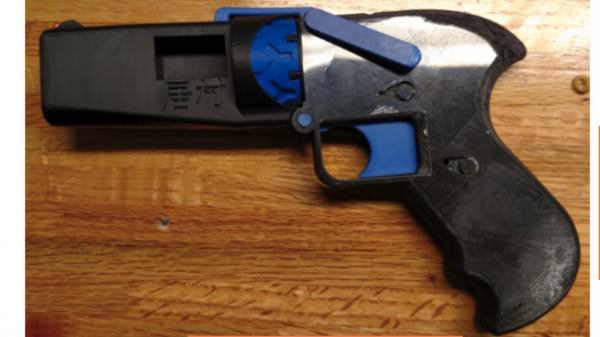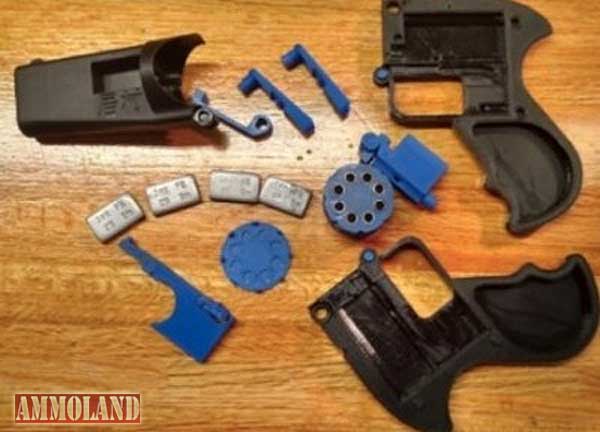By Dean Weingarten


Arizona – -(Ammoland.com)- An Imura revolver, 2.0 has been designed by that intrepid 3D engineering designer, Wayfairy.
He had to redesign the system, but the prints have been done and the prototype has passed the basic, non-firing function tests. From 3dprint.com:
One particular member of the community, known as ‘Wayfairy,’ has taken a particular interest in the Imura story. In fact he has set out to create a 3D printable gun honoring the incarcerated gun manufacturer, called the ‘Imura Pistol.’ Basically what he has done is take the original .38-caliber Zig-Zag revolver that had led to Imura’s arrest and revised it, making several key changes, designing a new gun from the ground up.
The major question is whether it will withstand the tensile forces that tend to separate the cylinder from the barrel and drive the case to the rear.
As you can see, the design is a hybrid, using metal tubing and 3D printing, that takes advantage of some of the best of both materials and technologies.
The gun itself uses .22 long rifle ammunition, and a .225″ ID 316 or 308 stainless tubing from McMaster. As for its appearance, just take a look at some of the images above and below. It’s a masterpiece in our opinion, and the only question left to be answered is whether or not it will actually fire a bullet without exploding in one’s hand.
As I wrote in September of 2014:
I see one weakness that the designers have probably noticed. There is very little tensile strength in the proposed design. Convention revolvers use a metal frame to contain the forces generated by firing a charge. The chambers contain the pressure at right angles to the barrel, but the frame, chamber, and case, if one is used, must contain the pressure to the rear. The projectile contains the pressure to the front, where the force is used to propel it out the end of the barrel.
If I were designing this revolver, I would consider the use of a bolt as a center pin for the cylinder to turn on. A simple backplate of steel could be made to screw the bolt into, adding tensile strength. It would not need to be circular, as long as it supported the rear of the chamber being fired. Removal of the bolt would allow the cylinder to be removed from the side of the design, so as to facilitate loading. Many conventional revolvers use this design feature.

Wayfairy did not use my free advice, but it is possible that the ABS plastic used will have sufficient tensile strength to fire a few shots. The potential points of failure that I see are; cracking of the ABS backing plate at the firing pin hole, and cracking of the lower split hinge.
If that occurs, there are fairly easy design fixes. A properly sized steel washer could be inserted between the backing plate and the cylinder. Size the washer just big enough so as to not quite reach the firing pin holes and it would not need any machining. That would likely solve cracking of the backing plate.

If the lower split hinge cracks, it should be possible to increase its diameter by 2X, or even 3X, which would increase the tensile strength by 4-9 times. If that were insufficient, my original suggestion of a center – pin made from a steel bolt would greatly increase the tensile strength. There is plenty of room in the cylinder for this, if it is necessary. If the bolt were combined with the washer, it could be threaded into a nut at the front or back during loading of the cylinder. Because this design does not rely on a center pin for indexing, and given the repeatability of 3D manufacture, several cylinders could be pre-loaded and used as a means of quick reloads during firing.
I would have no qualms about test firing this revolver, given a few safety considerations. I would wear gloves and ballistic eye protection, and hearing protection. My hat is off to Wayfairy, who is working under considerable constraints. The combination trigger, hand, and sear is an ingenious design.
As the people creating this interesting revolver are intelligent, they will likely function fire the prototype with primed casings, to insure ignition. In my first firing test, I would use Aguila Colibri .22 cartridges. It is likely that this design will have sufficient strength for them. They could move forward from there to destructive testing if they like, with more and more powerful .22 cartridges. The Colibri cartridges would be proof of principle, and would make a wonderful YouTube video with popping balloons or smashing Oreo cookies at a yard or two. They are as powerful as many air rifles.

These wonderful pictures are from 3Dprint.com, in the article by Brian Krassenstein.
c2014 by Dean Weingarten: Permission to share is granted when this notice is included. Link to Gun Watch
About Dean Weingarten;
Dean Weingarten has been a peace officer, a military officer, was on the University of Wisconsin Pistol Team for four years, and was first certified to teach firearms safety in 1973. He taught the Arizona concealed carry course for fifteen years until the goal of constitutional carry was attained. He has degrees in meteorology and mining engineering, and recently retired from the Department of Defense after a 30 year career in Army Research, Development, Testing, and Evaluation.

Great article, but are you sure it’s “Wayfairy” and not “Warfairy”? I suspect you may have been using autocorrect… Warfairy is a household name in 3D gun design!
Some 3D printers print layered metal. As the materials and the technology improves so will the design.